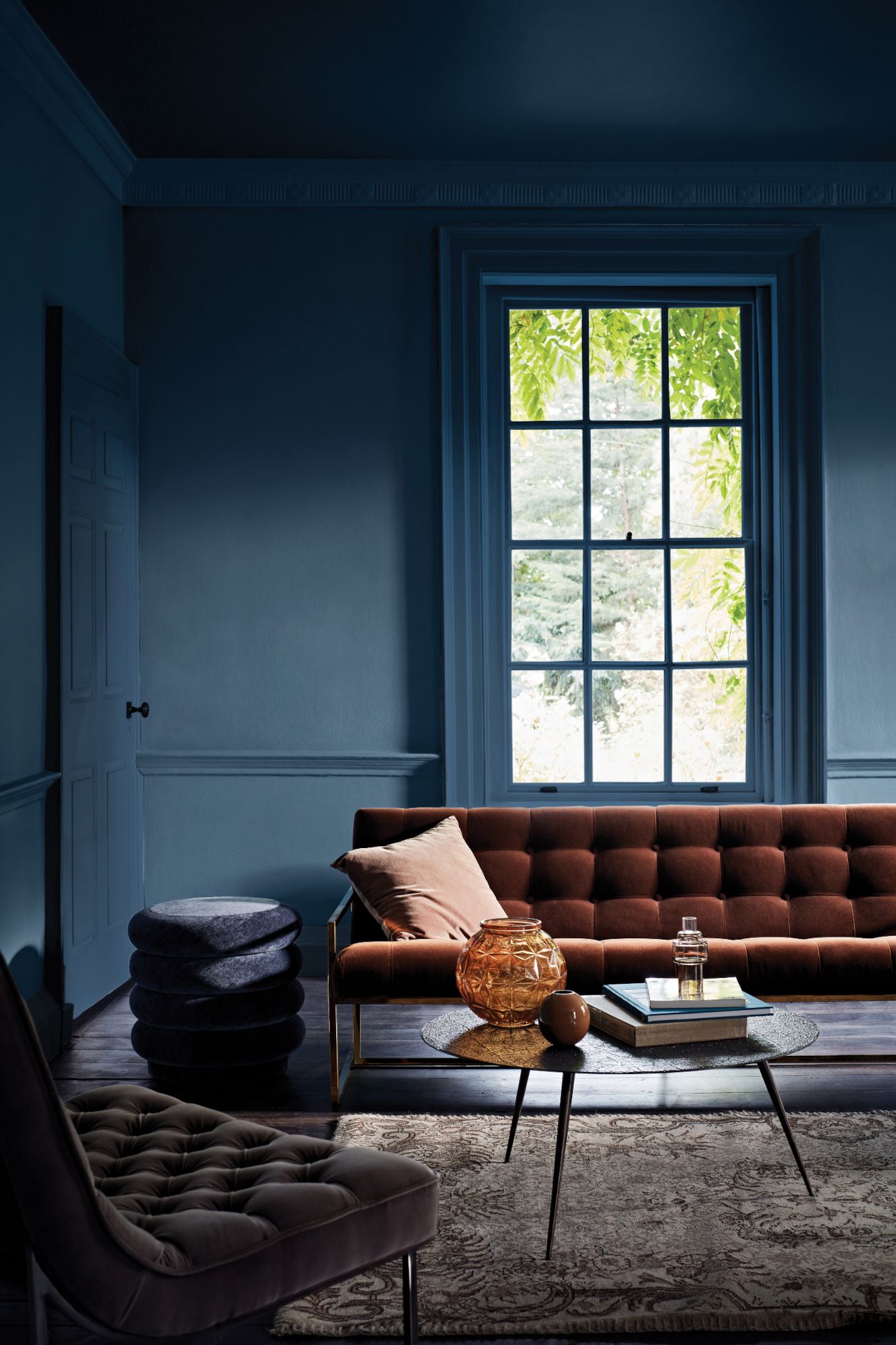Should you always paint a ceiling white? Designers explain when to go against this classic decor rule
We spoke to the experts about when and when not to paint a ceiling white – and what to try instead for a little extra pizzazz


We've seen a huge boost in confidence over using color in the last few years, but the decision to paint your ceiling white – or experiment with another shade – is still a tricky one.
The fifth wall, as it's sometimes known, can feel like something of an afterthought – either because we've spent so long deliberating over the perfect color for our walls, or because we're not quite brave enough to try something different. And while a colorful ceiling is one of the most popular paint ideas out there right now, you might be at a loss about where to start with choosing a shade.
So, should you always paint a ceiling white? We spoke to designers and paint experts to find out if there's still room for this classic scheme in a contemporary home.

Ellen is Livingetc's print editor, and an experienced interiors journalist. For this piece, she spoke to interior designers and paint and color experts to find out whether or not a white ceiling is always a good idea – and what they'd recommend instead.
Should you always paint a ceiling white?
Whether or not to paint a ceiling white ultimately comes down to one question: what kind of feeling do you want to create in your space? Most of the experts we spoke to were unanimous in their view that ceilings don't always need to be white, but it seems there's still room for keeping yours in this shade, if it works for your scheme.
‘There is absolutely no reason why a ceiling should always be painted white,’ says Lisa Marconi, owner of interior design studio DesignLed. ‘I like to consciously think of the ceiling as the fifth wall: that way it encourages clients to think what shall we do with it, in the same way you would a wall. Sometimes that will mean leaving it white, but it’s important you actually choose that as a design decision, rather than just defaulting to it. For instance, if it’s a busy room with a lot of pattern and color elsewhere, it’s probably best to leave the ceiling white.’
‘The short answer is no, ceilings shouldn't always be white,’ agrees Aaron Markwell, color lead at COAT Paints. In fact, he says, painting your ceiling in another shade is often more complementary to the room. ‘Often, when using darker colors on walls, the same color or a complimentary neutral are much better as softening the edges of the room and reducing contrast, which makes a room feel calmer,' he adds. 'This also helps the room feel taller, as your eye isn't immediately drawn to the contrast line with the white.’

Not all of the designers we spoke to were in agreement, however. ‘When it comes to painting the ceiling, it's very, very rare that we do a colored paint in our projects,’ says Emma Deterding, founder and creative director of Kelling Designs. ‘The reason for this is that although a colored ceiling may look gorgeous now, time will show that they really date a room. After all, would you really want a pink ceiling in five years’ time?'
Instead, Emma tends to choose an off-white color in her schemes – thanks to its ability to give a greater feeling of height, light and space to a room. 'We tend to use warmer tones of off-whites as opposed to white, as they bring a warmth and cosiness with them that helps create a calm and relaxed feeling,' she adds.
'White ceilings still have a place within the home – they offer a classic and fresh look and complement numerous design schemes, and they can make a room feel taller,' says Emma Bestley, co-founder and creative director of YesColours. 'Remember to ensure that the white ceiling echoes somewhere else in the room – for example, the paintwork on the windows and doors.'

‘There is no right or wrong answer as to what color a ceiling should be painted; it all depends on the room and your preferences,' says Helen Shaw, director at Benjamin Moore. 'White can definitely give the illusion of a higher ceiling, but don't be afraid to deviate from the norm and step outside your comfort zone. Adding a deeper color, for instance, can create a cosy, cocooning atmosphere perfect for a snug whilst a pop of bright color on the ceiling of a bathroom or kids room will be eye-catching and vibrant without being overbearing.’
And of course, there are also practical considerations when you're choosing a ceiling color. 'I would never say that a ceiling should only be painted white because I have worked on plenty of projects where we have successfully painted them other colors,' says Irene Gunter of interior design studio Gunter & Co. 'That said, it is worth considering that the majority of elements that get added to a ceiling, such as smoke detectors, air conditioning grilles and downlights, are white. So, if you do decide on a different color, you’ll need to factor in trim-less downlights and air conditioning grilles, and perhaps fitting a smoke detector in an adjacent room. Without doubt, a non-white ceiling takes more planning.'
How to find the right white for your ceiling
If you are choosing to paint your ceiling white, it's still crucial to pick the correct shade. 'White is great for reflecting light and creating a sense of spaciousness, and the right shade of white will do that while enhancing the whole space,' says Irene Gunter. 'You might think that finding this is a walk in the park, but in fact, the market is saturated. There’s everything from whites with cooling green or blue undertones to whites with a splash of red, pink or yellow mixed in to warm them up.'
So, how to navigate this world of white paint? 'To be sure you have the winning white, I highly recommend you test samples – and lots of them!' says Irene. 'By comparing a range of whites with the color (or colors) you’ve chosen for your walls, you can truly appreciate how one white can differ from the next.'
Another option is to create your own shade by mixing brilliant white with another neutral. ‘I would never paint a ceiling bright white,' says interior designer Sarah Vanrenen. 'We always mix our ceiling color 50/50 white and Farrow & Ball Pointing to make the tone a bit warmer.'

Pointing 2033 by Farrow and Ball
With its slightly red undertone, this warm white paint by Farrow and Ball takes its inspiration from the pointing used in classic brickwork, and as Sarah Vanrenen suggests, is ideal to mix in with white for a softer approach to ceilings.
When should you use color on a ceiling?
While there are clearly benefits to painting your ceiling white, then, there are just as many to choosing color instead. The experts had plenty of clever painted ceiling ideas to share, as well as advice on using color on the fifth wall if this is your first time doing so.

Jitney 293 by Farrow and Ball
'I truly believe that Jitney is the best paint color ever,' says Pip Rich, Livingetc's editor. 'Yes, that's a bold claim, but it's so warm, so soft, so enticing. It can't be beaten. I have it on the ceiling in my snug and I love it - it is just a touch less brilliant than white and feels so much more cocooning.'
1. To make your scheme feel more pulled-together

In schemes where a white ceiling might feel jarring – against darker walls, for example – many of the experts recommended painting the ceiling in a lighter shade of that on the walls instead. And the best ceiling color in this case might be easier to find than you think.
'In the master bedroom of this Notting Hill family home we used Paint & Paper Library’s Rouge II on the bottom three quarters of the wall, and that same color with 50 per cent white mixed in to create a lighter shade for the top quarter of the wall and across the ceiling,' says Irene Gunter. 'This paint technique not only adds interest, but makes the room look taller.'
2. To create a cocoon-like space

A white ceiling rarely lends itself to a truly cozy space – so instead, look to darker colors to create this effect. ‘I like to paint a ceiling in a contrasting color when we’re trying to make a room cozy or cocoon-like – especially when we’re using darker colors,’ says Lisa Marconi. ‘It just creates that wonderful feeling of being enveloped by a room.'
She's also a fan of color drenching – the popular all-over paint technique that creates the ultimate intimate feeling in a space. 'Sometimes we’ll just go the whole hog and envelop the room in the same strong shade!’
Alternatively, use color contrast to add a playful touch to your scheme. 'Try something a little different by using a really bright color such as Crown’s Mustard Jar on the ceiling so the color visually spills onto plain white walls below,' says Justyna Korczynska, senior designer at Crown. 'Alternatively, play with tones to suit your palette. A dark turquoise, for example, on the ceiling would partner suitably with mid and paler tones for the walls.'
3. To incorporate texture into your space

If a white ceiling feels a little flat, incorporating color with a textural paint finish is a way to lift your scheme – and add a little pizzazz. ‘The ceiling can be a great place to add some glam,’ says Lisa Marconi. ‘Using a lacquered finish creates instant wow and is great if you feel having a finish like that on the walls would be too much.'
A bolder alternative, if you want a truly showstopping scheme, is to opt for a metallic finish. A brushed gold paint effect will act as a reflective surface, bouncing light around the room and adding a real element of glamor to the space.
4. To create a playful design for a kids’ room

While Emma Deterding tends to steer away from colorful ceilings, the one place she will make a statement overhead is in a kid's room. ‘The ceiling is an area of a room that can often be overlooked, but with some clever design tricks, you can make a real statement from above,’ she says.
‘For instance, in a child's bedroom, you can create a really fun tent-like ceiling with fabric. Once you've established the theme of the bedroom, be it fairytale, circus or jungle, you can then pick fabrics in colors and prints to suit and hang from the centre, draping out to the sides to add drama and a coziness.'
For Emma Bestley, this playful touch need not be limited to one room. 'Play with patterns to create zones within a room,' she says. 'Checkerboard, for example, works beautifully – a classic pattern that adds a little grandeur. If you're hand painting, patterns can be scaled accordingly to suit your chosen room.'
5. To highlight architectural details

Opting for color over white paint on your ceiling can help you make the most of period features in a room. ‘A painted ceiling can be great as a way to highlight beautiful mouldings,’ says Lisa Marconi. ‘If you’re lucky enough to have a house with gorgeous detail around the ceiling – picture rails, ceiling roses, ceiling detail – then painting above the picture rail and bringing it over the ceiling is a great way to draw the eye up to all that gorgeous detail. This works well to highlight panelling detail as well.’
6. To play with painterly effects

‘Another beautiful take on a creative ceiling is to play with painterly effects,' says Emma Deterding. 'Decorative paint finishes have really come along and are often the creme de la creme or the biggest cheat!' She uses the example of marble columns in stately homes – 'which you would expect to be stone but have actually been painted to look like stone.'
How to bring this effect into your own home? 'A talented decorative painter can create a bespoke finish that can not only transform a room, but set the tone and texture for the space,' Emma adds. 'They are true magicians with color and can see and combine many different shades within the effect – something that is just so standout and unique.The same process can be easily applied to the ceiling, whether you create a beautiful mural, a panelled ceiling or even a starry night sky.'
Be The First To Know
The Livingetc newsletter is your shortcut to the now and the next in home design. Subscribe today to receive a stunning free 200-page book of the best homes from around the world.

Ellen is deputy editor of Livingetc magazine. She cut her teeth working for sister publication Real Homes, starting as features editor before becoming deputy editor. There, she enjoyed taking a peek inside beautiful homes and discovered a love for design and architecture that eventually led her here. She has also written for other titles including Homes & Gardens and Gardeningetc. While she gets ready to buy a house of her own, she takes inspiration from the works of some of her favourite architects and tastemakers. She has a particular passion for green design and enjoys shopping small, local and second-hand where she can.
-
 The 12 Best Table Lamps for Reading —I'm a Certified Bookworm (and Shopping Expert)
The 12 Best Table Lamps for Reading —I'm a Certified Bookworm (and Shopping Expert)When it comes to table lamps for reading, I don't mess around. If you're the same, this edit is for YOU (and your books, or course — and good recommendations?)
By Brigid Kennedy Published
-
 "It's Scandi Meets Californian-Cool" — The New Anthro Collab With Katie Hodges Hits Just the Right Style Note
"It's Scandi Meets Californian-Cool" — The New Anthro Collab With Katie Hodges Hits Just the Right Style NoteThe LA-based interior designer merges coastal cool with Scandinavian simplicity for a delightfully lived-in collection of elevated home furnishings
By Julia Demer Published

